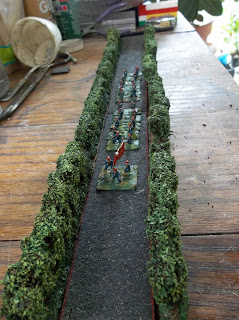My first gaming night in over three years at my old club was a family occasion. My wife came along as war correspondent, and Amanda, my archaeologist stepdaughter, decided she'd like to find out more about gaming. The club membership has expanded considerably since its early days, with easily four times as many folks in the hall last night. A nice bunch of fellows, they made us welcome, and we settled down to game.
My choice for the evening was a 28mm game set in Spain, 1050 AD - the beginning of the era of El Cid and the expulsion of the Moors from the Peninsula. Amanda is developing her studies into the Iron Age. She and I fielded Christian Spanish/Normans vs. Abussid/Berbers. We used Impetus rules, which I hadn't tried but heard good things about.
Three gamers contemplate their forces.
The terrain was generated at random and featured two sizable woods and two small but craggy hills. Set-up by both sides used hidden deployment. We decided to concentrate our heavy infantry on our left flank facing the most cluttered terrain. The majority of the cavalry, including my high-quality Normans deployed on our right, where the terrain between woods and hills was more open. From my location I could cover the avenues of approach. Our center had a reserve of heavy cavalry, screened by Basque light cavalry and skirmishers armed with bows, crossbows and javelins.
Gamer at play - contemplating the soon-to-be-destroyed Berber forces.
My light cavalry are poised to slam into their counterparts to the left of the shot. Stuart presides over all.
Our opponents had more cavalry, but - we guessed - of a generally lower quality. They divided them between both flanks, with the Normans soon facing off against the Berber nobility.
A general view of the tabletop. My Normans get to blows with the Berbers nearest the camera. Off in the distance is a Flames of War: Holland - 1944 game.
Impetus relies on U-Go-I-Go movement using initiative dice. The rolls favoured both sides about equally. Firing is more effective within 10" range for bow and crossbow armed troops, although the effects can be mitigated by dice rolls. Both sides found it rather frustrating to get a few valuable hits only to see their opponents shrug them off.
As the main cavalry thrust developed to our right, I rode out to meet it. It soon became apparent the main Berber infantry attack would develop on our left, once they had found their way through the difficult terrain. That aspect of the battle was in Guy's hands.
The cavalry melee developed, with my forces winning the roll and charging into contact. It turned out to be a more difficult task than I anticipated. I had every confidence I would win the day, but the opposition put up a good fight. One of my cavalry units succeeded in destroying a (supposedly) less able enemy force, but had to be led, fainting and gasping, to the sidelines after suffering a battering in return.
On the other flank, Amanda became worried about the developing threat. The Berbers had pushed forward the rest of their cavalry and were bearing down on our largely immobile heavy infantry, backed by their own infantry. (At this early stage of the Reconquest, the heavy infantry of Christian Spain lacked the long spears which later proved so effective against cavalry. The Berber infantry were well-equipped with these spears from the first). Amanda sent her cavalry speeding across to assist Guy's forces, and arrived in the nick of time.
In the center my light cavalry charged and put to flight a unit of Berber light cavalry that had unwittingly exposed themselves to danger. A follow-up charge put paid to a hapless unit of crossbowmen who had - to that time - posed no real threat to us. This blew a nice big gap in the Berber line, and put worried expressions on the faces of our opponents. They had spent most of the game getting their heavy infantry over the hills. Now they had to stop and turn to face my light cavalry - or risk a charge into their flank. A band of Berber javelin-armed skirmishers in the wood tried ineffectually to harass the cavalry, but wisely decided to lie low and take no farther part in the battle.
Amanda's cavalry helped Guy ward off several serious attacks which would otherwise have destroyed his infantry, although one unit was caught in the rear-flank and obliterated. A charge by her heavy cavalry caught and destroyed the enemy after a brutal to-and-fro contest.
Over on the right, my cavalry charged and counter-charged. I lost one unit, which put us perilously close to the army break-point. But soon after I ground the Berber nobility beneath the hooves of my Norman heavy horses, and that put paid to the Berber ambitions. Their break-point had been passed. Game over.
Amanda enjoyed her first game and is looking forward to a new meeting next week. Our thanks to Guy, Stuart the umpire, and our opponents Chris and Mark for a great game.



















































